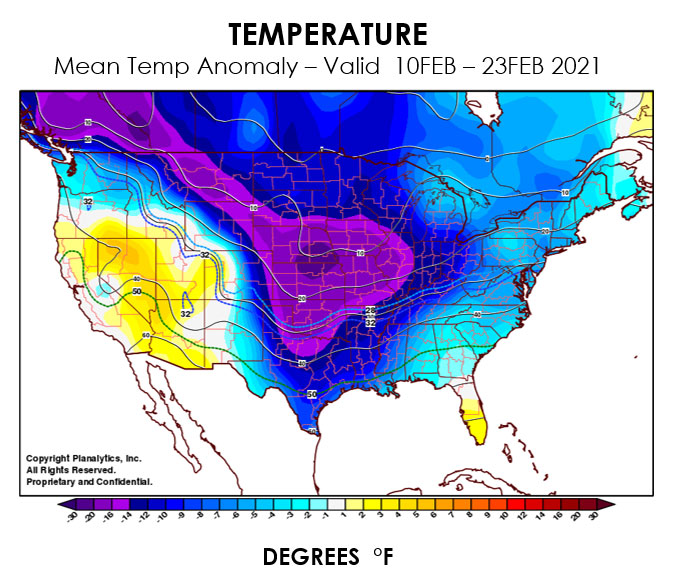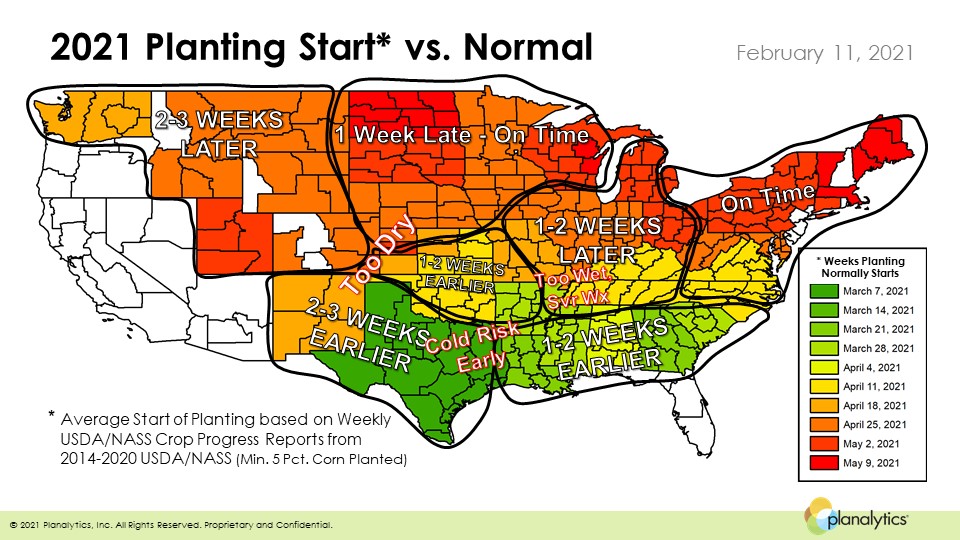Producers are making business decisions that impact not just input purchases for 2021 but also farm bill and crop insurance signup. To help producers make informed risk management decisions, we teamed up with Planalytics, a global leader in business weather intelligence, to provide perspective on this winter’s weather and possible conditions for the planting and growing seasons.
February, of course, stands out this winter for its frigid temperatures. The current polar vortex is a challenge for livestock producers, particularly those with calving taking place in the next 30 days, said Tony Jesina, Farm Credit Services of America (FCSAmerica) senior vice president for insurance. Longer term, conditions point to an increase in severe weather, compared to normal. Below is region-by-region outlook.
Setting the Stage for 2021 Growing Season
 Drought conditions exist in much of our service area. Snowfall in the Dakotas and northwest Iowa since September has been below the normal, 30-year average. Snow depth in much of the rest of Iowa and Nebraska is above normal and more is expected.
Drought conditions exist in much of our service area. Snowfall in the Dakotas and northwest Iowa since September has been below the normal, 30-year average. Snow depth in much of the rest of Iowa and Nebraska is above normal and more is expected.
It takes 10 to 15 inches of snow to equal just 1 inch of moisture. Given current soil moisture deficits (map), there’s a good chance for less than ideal moisture at planting.
March and April are expected to turn drier in most of our territory. The exception could be South Dakota, where producers might experience wetter-than-normal conditions in April.
Both the Dakotas and Iowa could see widespread moisture patterns in May, “but rains will be intermittent and should not interfere with field work,” said Michael Greve, Planalytics’ head meteorologist.
Much of Nebraska and Kansas are expected to see average to much drier-than-normal weather, which should facilitate planting.
Planting Prospects
Planalytics predicts Kansas corn planting may get started in early April. Farmers in most of Nebraska, Iowa and South Dakota should be able to get into their fields in mid- to late April or, in the northern areas, May. Late-season snow isn’t out of the question in the Dakotas.
Southeastern Iowa may run a week or two behind normal due to wet conditions, and Wyoming could be two to three weeks behind normal due to lingering cold. (See map for normal planting dates and Planalytics’ expectations.)

“The background for this year’s weather is that we’re going into spring with a low reserve of soil moisture, coupled with what appears to be more variable weather come spring planting,” Jesina said.
Looking at various regions, Planalytics’ meteorologists highlight the following:
Southern Plains
Most of Texas is at or above 50°F soil temperatures, which will likely lead to early planting. A strong blast of cold air this week could push some operations back, but the low likelihood of precipitation should allow planting to proceed. Too-dry conditions could present problems in more western locations.
Central Plains
Warmer temperatures in late March into April, with most of the heaviest precipitation occurring farther east, should allow for early to on-time planting for most areas. Too-dry soil conditions will be a problem for some, especially farther north and west.
Corn Belt
Drought will continue to be an issue for the Western Corn Belt. The farther north and west the operation, the greater the chances colder temperatures and lingering snow cover could delay planting a week or two. Frequent storms also could delay planting across the Central to Eastern Corn Belt, but temperatures should be warm enough to plant on time.
Delta
Warmer temperatures should provide most with early to on-time planting windows. Heavy rain and severe weather could cause delays in more northern locations closer to the Tennessee Valley and Arkansas.
Eastern United States
Normal to warmer temperatures in April and early May should provide conditions for on-time planting. Precipitation could cause delays in western locations.
Severe weather outlook
Flooding, which Planalytics was one of the first to predict in 2019, is not likely this year.
“I’m concerned about the possibility of the lower Mississippi River flooding because of heavy rainfall,” Greve said. “But if it occurs, it will not have the widespread effects of 2019. It’s possible ice jams could cause local flooding, but we just don’t have the snowpack that was important in 2019’s disastrous floods.”
February and March, clashing air masses could spell periods of heavy rain and the chance for hail and tornadoes in the South. Those forces will push westward into April and farther West in May. Odds of severe weather are higher than normal in Kansas during May; Iowa in June; and Nebraska and South Dakota in July and August, according to Planalytics. The eastern part of the U.S. faces threats through its entire growing season.
“One of the best analog years is 2011, a year that was marked by a high number of severe weather events,” said Jeffrey Doran, director of specialized support and services for Planalytics.
“Most of our territory is predicted to an increase in severe weather compared with normal,” Jesina said. “Given the current commodity prices, I’d encourage producers to meet with a member of our insurance team to understand what strategies and solutions are available to offset that increased risk.”

For details and a look at the main weather-drivers this year, watch our webinar recording. On the video playbar, click the three bars icon ( ) to navigate to a specific section.
) to navigate to a specific section.
We plan an early-season update and state corn and soybean yield forecasts in June.

